Introducing your soon to be favorite Asian culinary ingredient – creamy rich nutty homemade black sesame paste made from scratch. This deeply rich charcoal black condiment is exquisite in desserts like nice cream, lattes, sesame pie cookies, savory recipes and more.
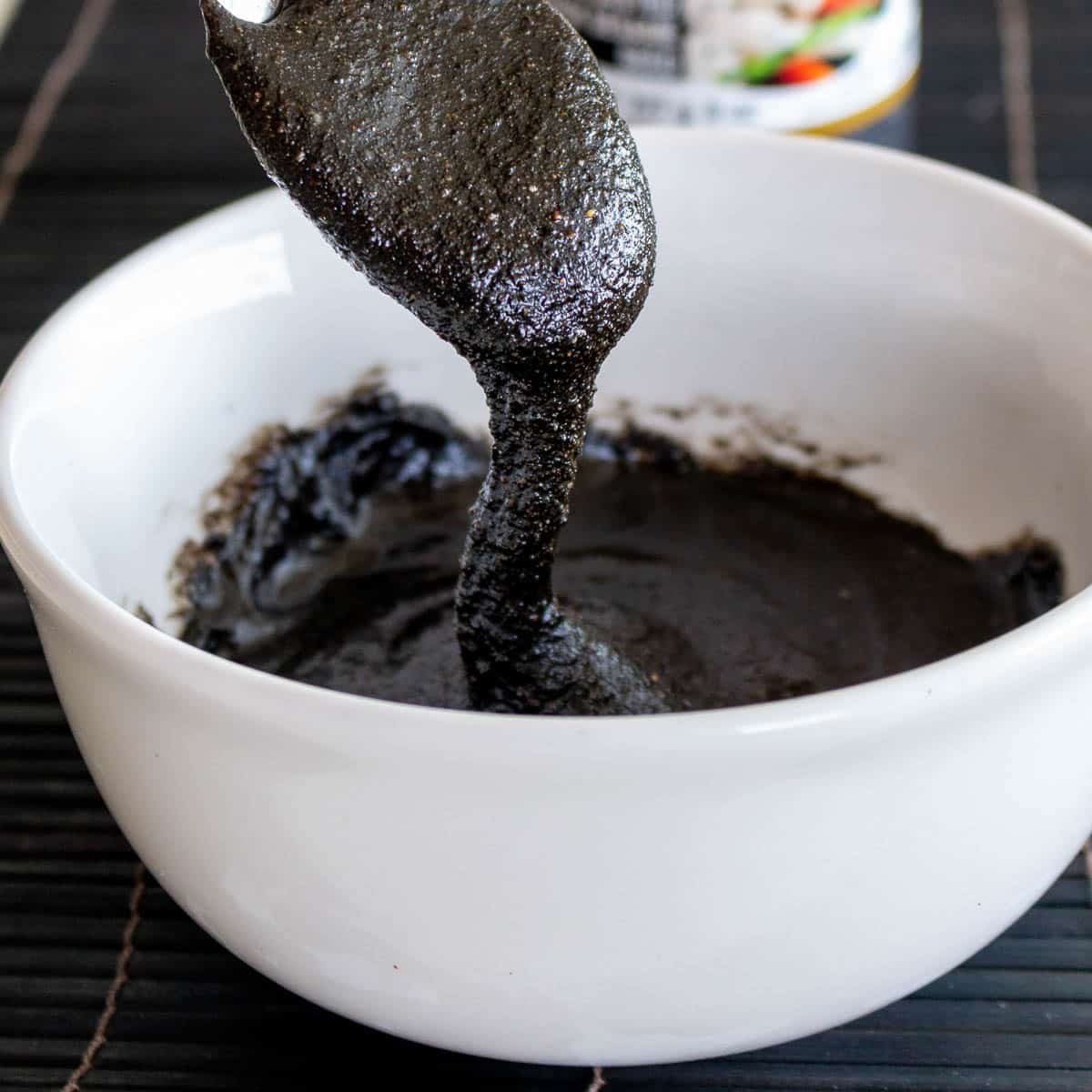
Learn how to make this deliciously smooth 2 ingredient recipe in just 10 minutes using either a small food processor, high speed blender or even a mortar and pestle. In addition, this all-inclusive guide is packed with easy helpful hacks and lessons learned the hard way, so you don’t do the same.
Jump to:
- How to Use
- What is Black Sesame Seed Paste?
- What does it taste like?
- Ingredients (Sweet and Savory)
- How to Make It: Different Methods
- Variations and Substitutions
- How Much Paste?
- How to Store
- Helpful Recipe Tips
- Recipe Hacks Learned the Hard Way!
- Frequent Asked Questions (FAQ’s)
- More Recipes Using Sesame Seeds
- Homemade Black Sesame Paste
How to Use
It’s confession time. No judgement please but we made 4 batches of this recipe in the last 2 weeks alone. Not only is it more budget friendly to make your own at home but it tastes so much better than the store bought. Delicious sweetened and slathered on rice cakes, cloud bread, drizzled over oatmeal, or enjoyed in baked goods, nice cream, smoothies, energy bars, truffles and more.
But of course, we can’t forget how delicious black sesame seed paste is unsweetened in savory dishes like marinades, Asian dipping sauces or even added to noodle dishes. The number of ways to utilize this delicious seed paste is only limited by your imagination.
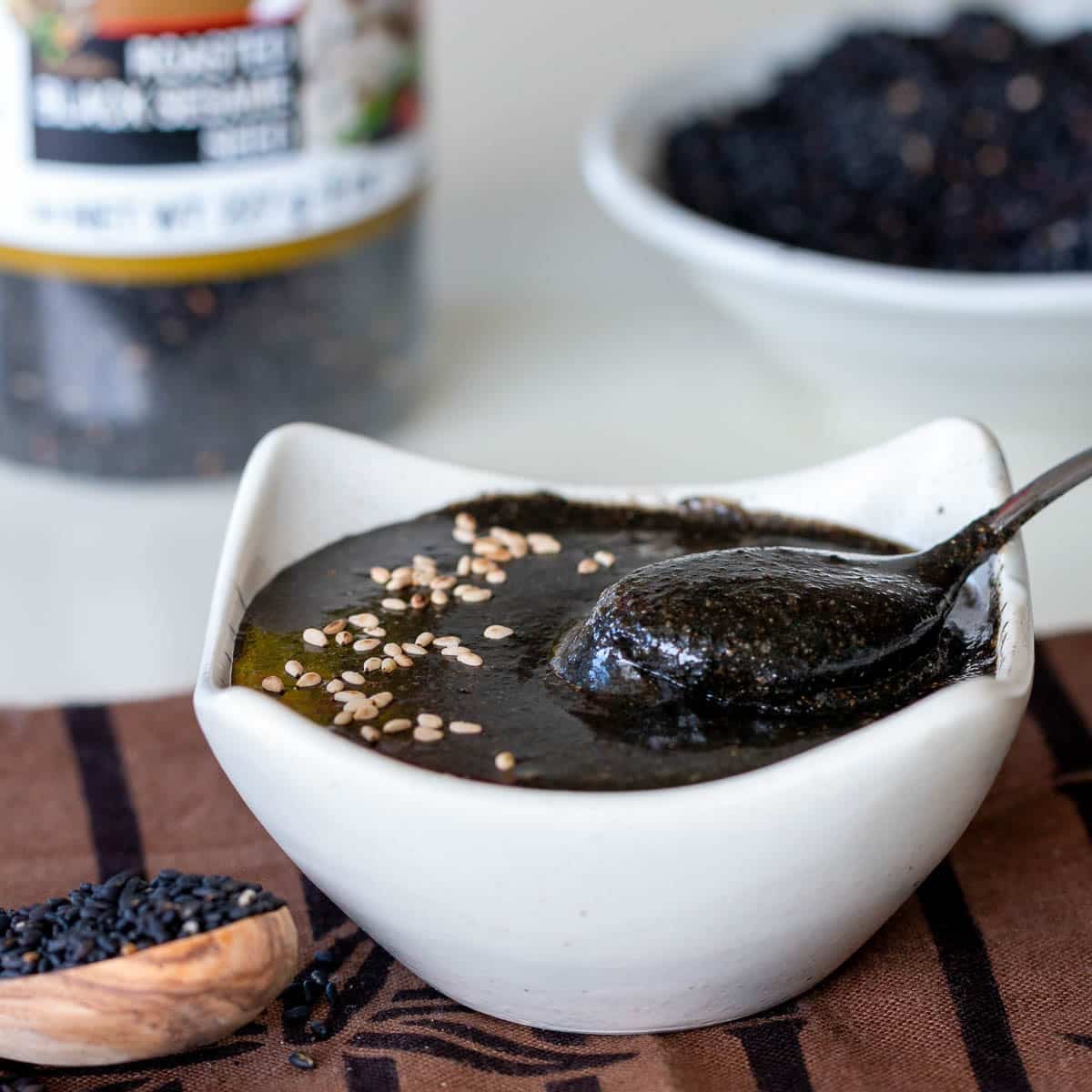
What is Black Sesame Seed Paste?
In Japanese, this recipe for black sesame paste is sometimes called kuro neri goma, and in Chinese, it goes by hēi zhī ma hú. It has been a staple in Asian kitchens for decades. Black sesame seed paste is made using toasted black sesame seeds that are first ground into a fine powder.
After more time grinding, the sesame seeds will start to release some of their natural oils. Finally, either a liquid sweetener like honey or sesame oil for the unsweetened version is added to thin the paste until the desired thickness is achieved. Essentially, sesame seed paste is like a nut butter but made with seeds instead- just like our pumpkin seed butter.
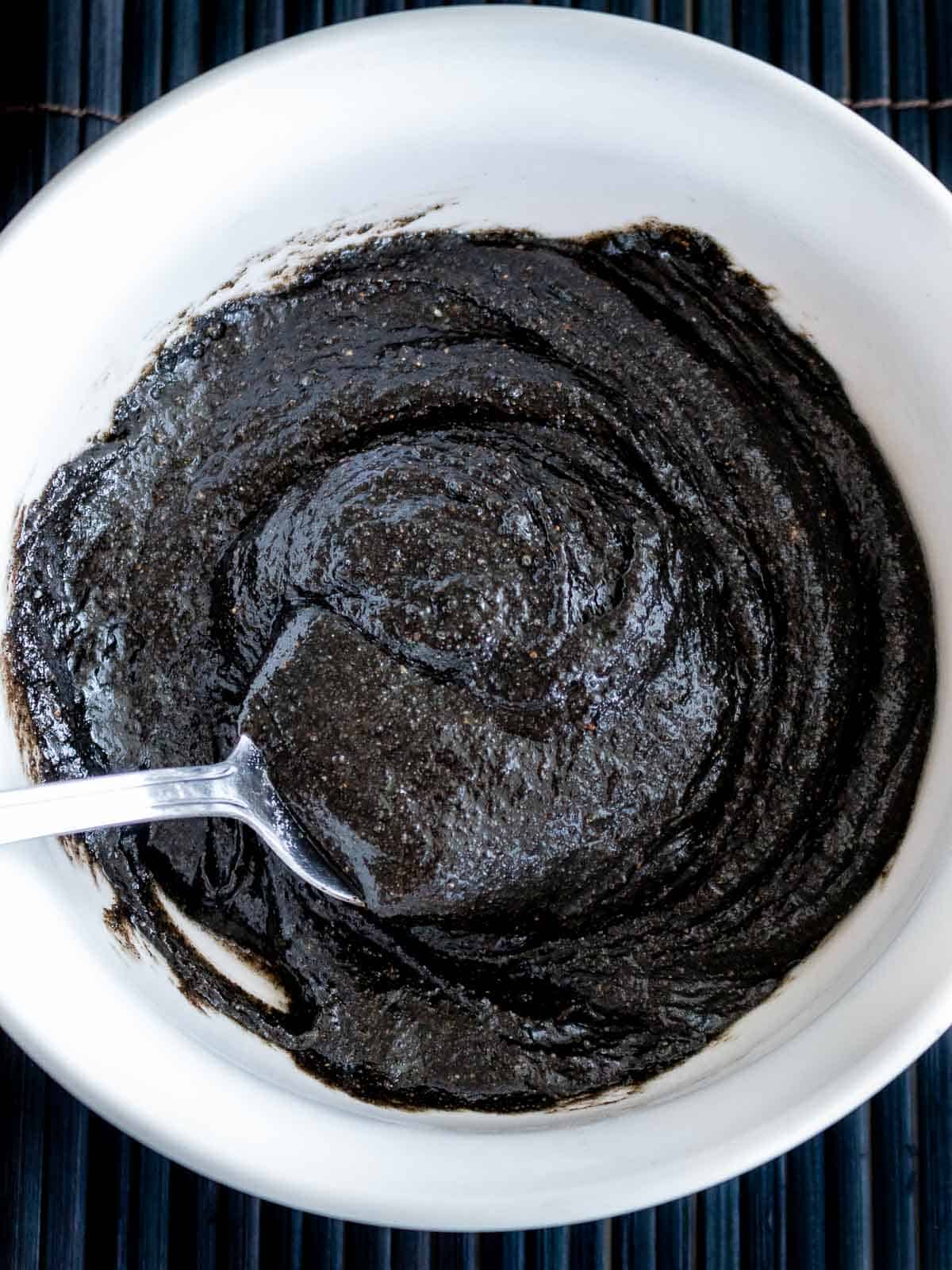
What does it taste like?
The roasting of the black sesame seeds is what intensifies its unique flavor. It also gives it that distinctive dark charcoal black color. Toasted black sesame paste is deeply nutty, earthy, naturally lightly sweet with a slight hint of bitterness. In addition, the tantalizing aroma is out of this world.
Depending on what additions you add to the sesame seeds, it will add another dimension to the flavor. For example, honey is often used to sweeten the paste and it gives it a slightly firmer texture. Depending on where the bees collected the nectar from, it may impart a lightly sweet floral or citrus flavor. On the other hand, the addition of sesame oil will intensify the nutty flavor of the sesame seeds.
Hop on this new popular food trend in Asia! You have no idea what you have been missing out on. Living in Japan we always looked forward to black sesame mochi donuts. Whilst in Hong Kong, you can’t pass up a freshly made black sesame cereal. We just can’t seem to get enough of it.
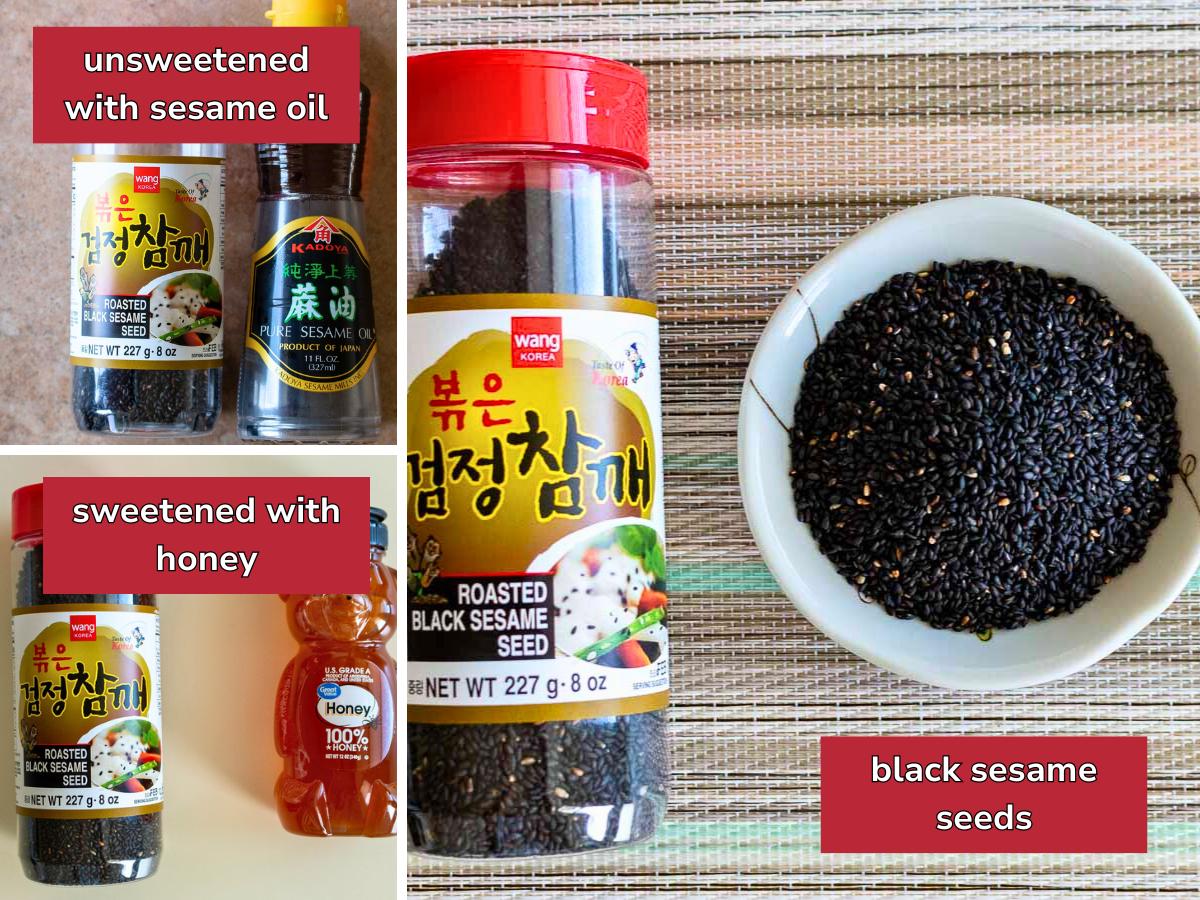
Ingredients (Sweet and Savory)
Black Sesame Seeds – organic and unhulled are preferred to hulled seeds. The unhulled variety contains more health benefits and has a deeper flavor. But, at the end of the day - use what you have on hand. The seeds can be either toasted or raw. If your sesame seeds are raw, it will just take a bit longer to toast them. If you have extra sesame seeds, try them in a homemade furikake seasoning.
Honey (Sweetened Paste) – raw organic is the healthier option but use what you have on hand. If you want to make this recipe vegan, try maple syrup or agave in a 1:1 exchange for honey. We haven't tested this recipe with alternative sweeteners like liquid stevia or monk fruit.
And/or
Sesame Oil (Unsweetened Paste) – toasted and either regular or black sesame oil. In the perfect world, organic and extra virgin cold pressed oil would be lovely. If you do not have sesame oil, you can exchange it with a light-flavored oil such as olive, grapeseed, walnut, avocado, or peanut oil. Note that this will slightly alter the flavor profile.
How to Make It: Different Methods
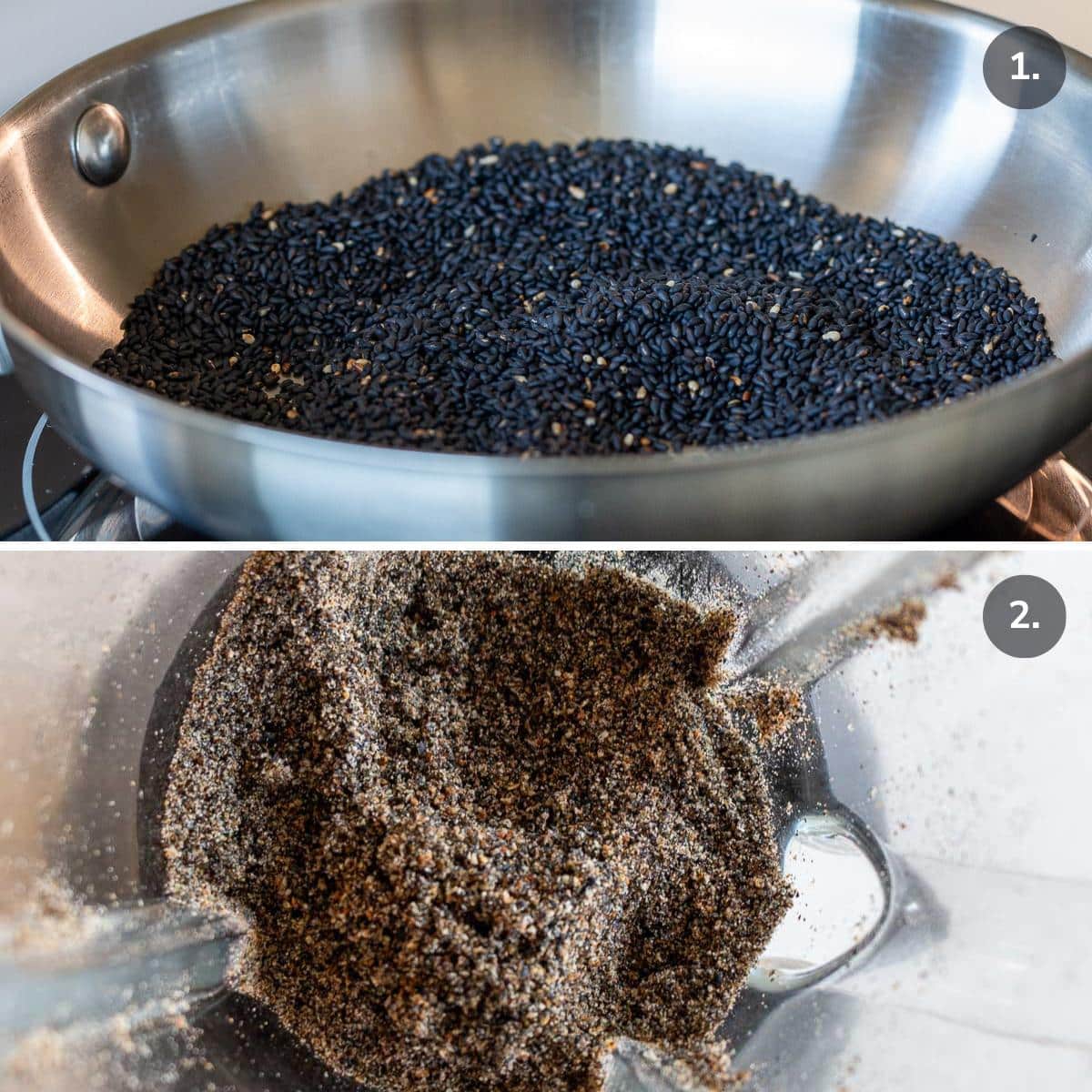
- Toasting Sesame Seeds: Sauté the “toasted” black sesame seeds over low heat for approximately 5 minutes until aromatic and warmed.
- Grinding: Use a Food Processor, High-Powered Blender or a mortar and pestle. Grind the seeds until it resembles a fine, sandy texture. You may even want to grind extra black sesame seeds for gluten free sesame cookies.
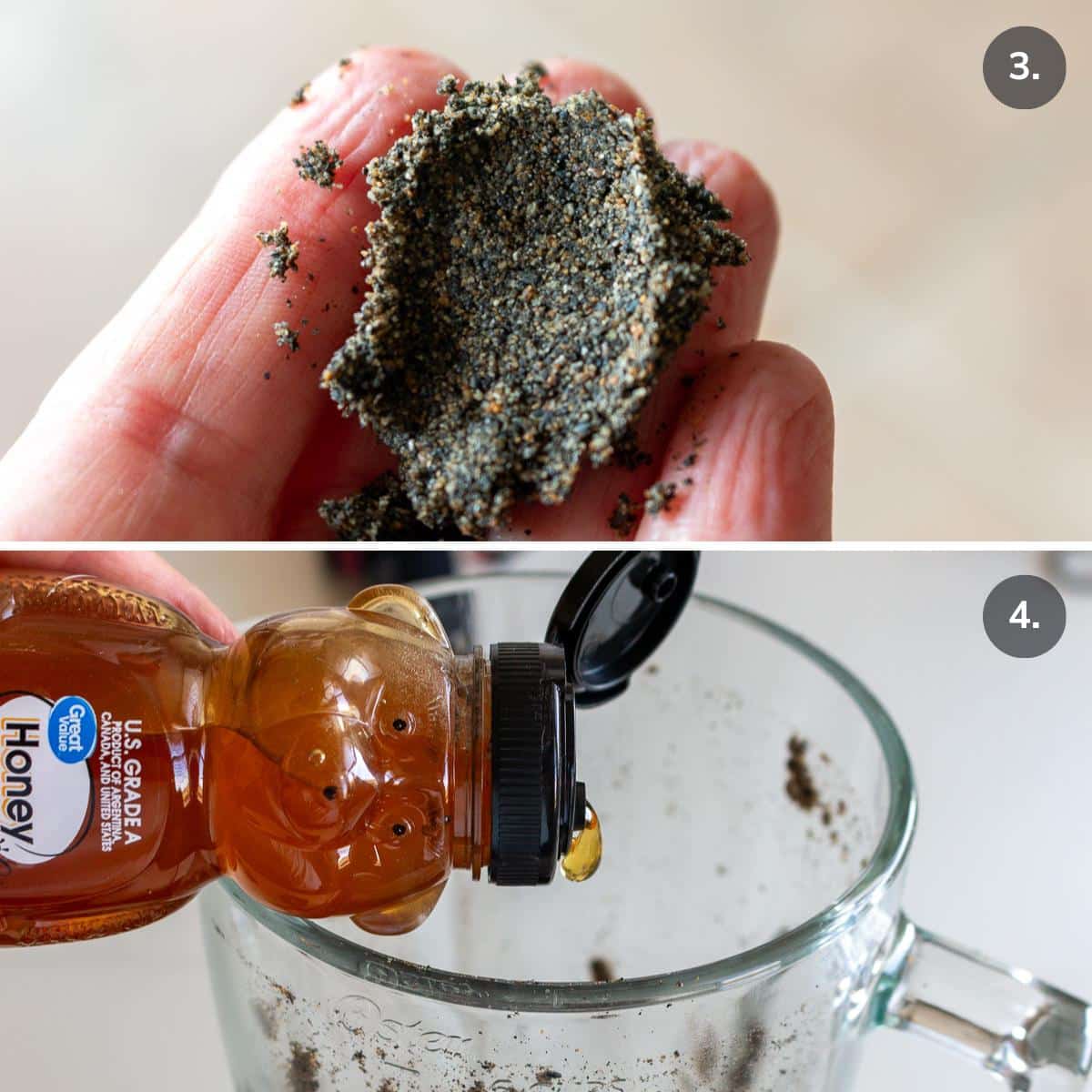
- Scraping Down: Periodically pause the device and scrape down the sides. This helps to move the seeds down to the blades of the machine or center of the mortar.
- Blending: Continue to pulse and blend the black sesame seeds until they start to extract the oils from within the seeds. If your blender or food processor allows it, continue grinding until a paste is formed.
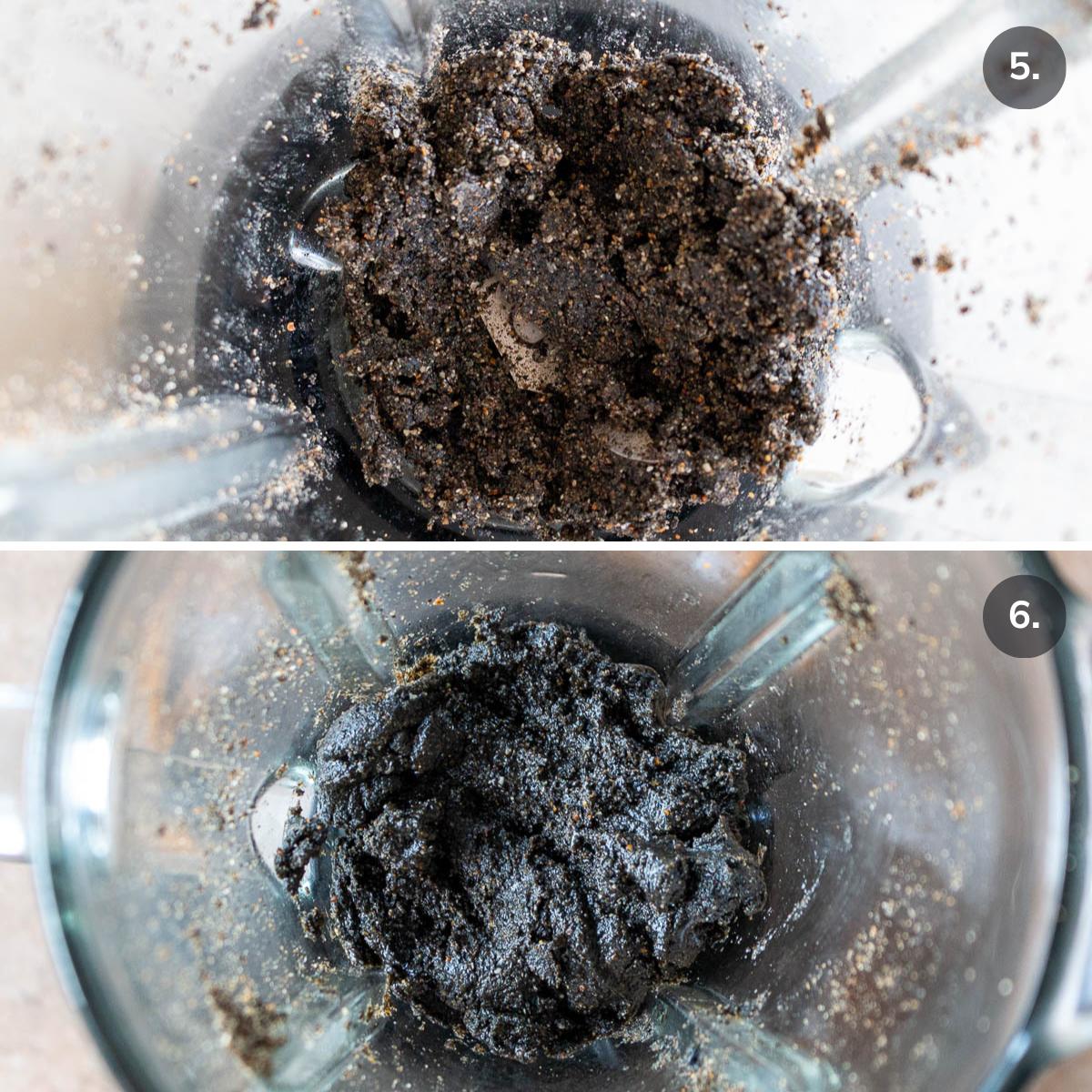
- Honey or Sesame Oil Addition: For the sweetened version, add honey 1 tablespoon at a time or until the desired texture. (Total between 4-5 tablespoons.) Craft the unsweetened version by adding 1 teaspoon at a time of sesame oil until you reach the desired texture. ( Approximately 1 to 1.2 tablespoons)
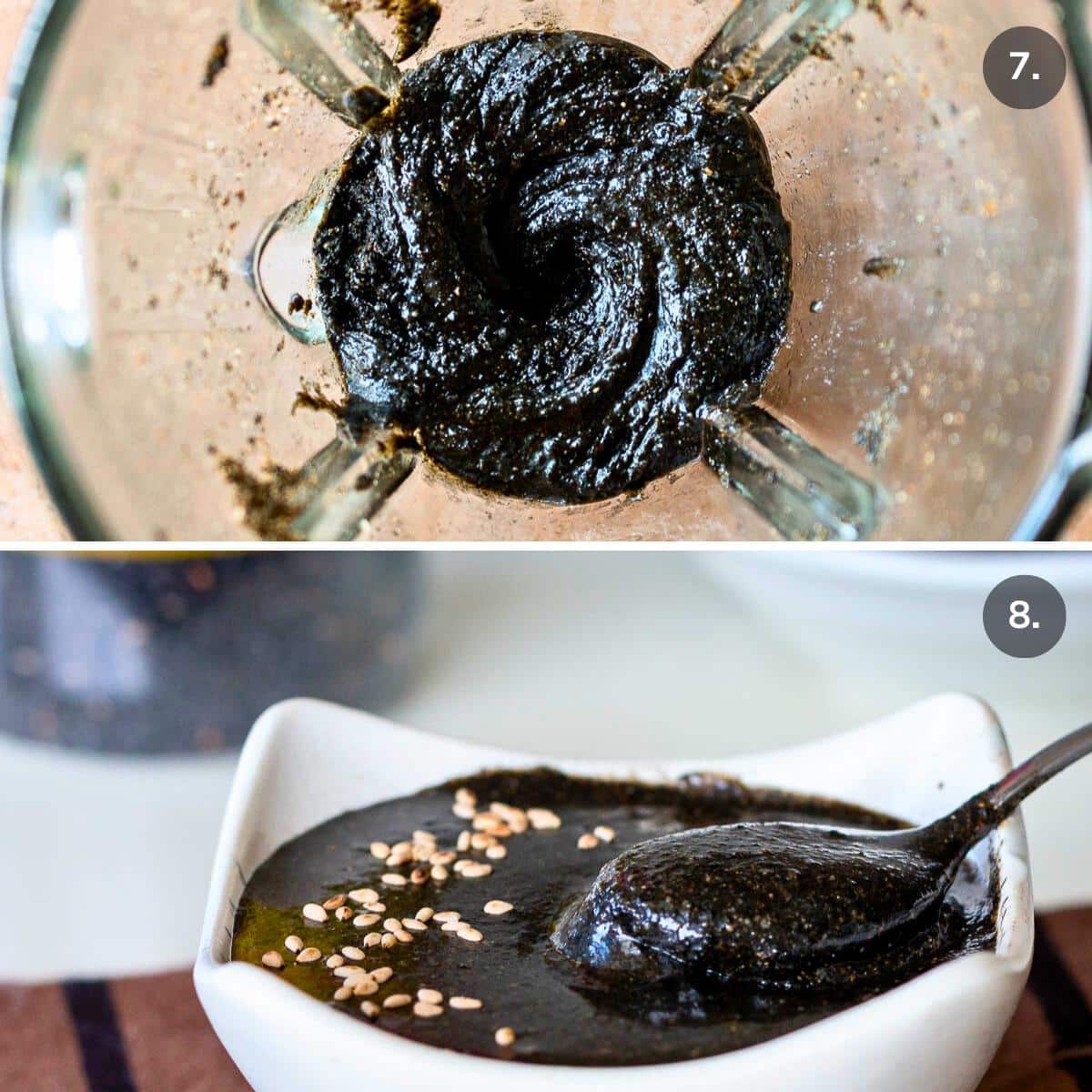
Variations and Substitutions
- Water Instead of Sesame Oil: To keep the fat down, add 1-2 tablespoons of water instead of sesame oil. Please note, that this will reduce the days it can be stored to 5 to 7 days in the refrigerator. In addition, it will not be as shiny and there is a higher risk of spoilage.
- Sweetener Alternatives: To keep the condiment vegan, exchange the honey with 1:1 maple syrup, agave, dates, or date paste. We do not suggest using sugar granules as this may make the paste gritty.
- Flavor Additions: Add a little bit of vanilla extract, ground cinnamon or cocoa powder while mixing .
- Noodle Sauce: Make a delightful Asian noodle sauce! Mix natural peanut butter, chili sauce, soy sauce and rice vinegar with the black sesame paste. Adjust the amounts based on your taste preferences.
- Thinning the Paste: Consider thinning the paste out with 1 to 2 tablespoons of water. Recipes like ice cream, black sesame milk or lattes are easier the mix when the paste is thinner.
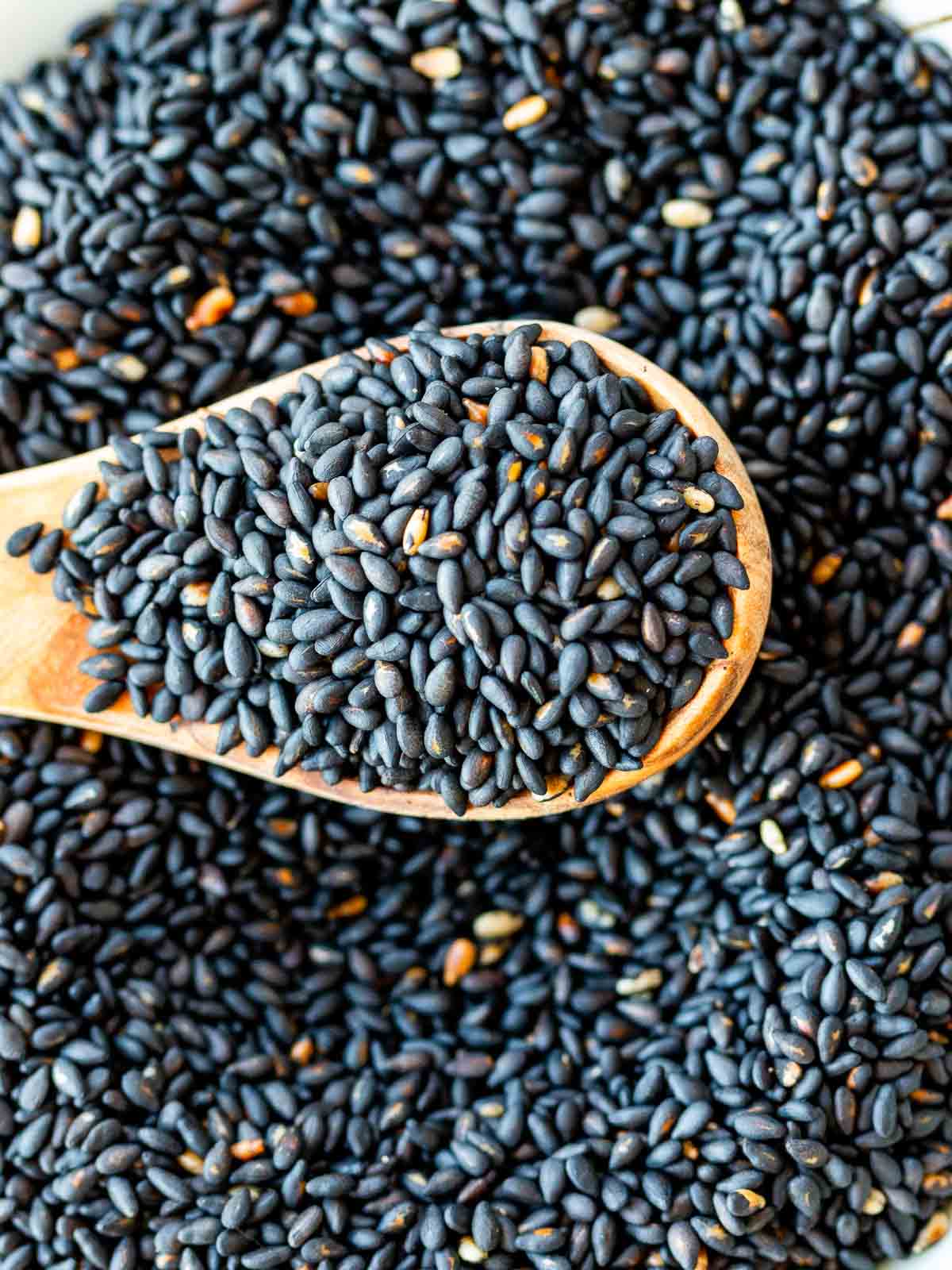
How Much Paste?
The yield of sesame seed paste can vary based on several factors. These factors include the quantity of sesame seeds used, their moisture content, and the efficiency of the blending process. However, as a general guide:
Starting Amount: If you begin with 1 cup of sesame seeds, you can typically expect to get approximately ½ to ⅔ cup of sesame seed paste.
Yield Variation: The yield may vary depending on the specific type of sesame seeds, their freshness, and the blending equipment used. Some seeds release more oil than others, affecting the final consistency of the paste. Were you meticulous scrapping the black sesame paste out from the blender or food processor. Did you find yourself performing lots of "quality control" testing? (smiling)
Adjustments: You can adjust the thickness of the paste by adding liquid (like honey or sesame oil) during the blending process.
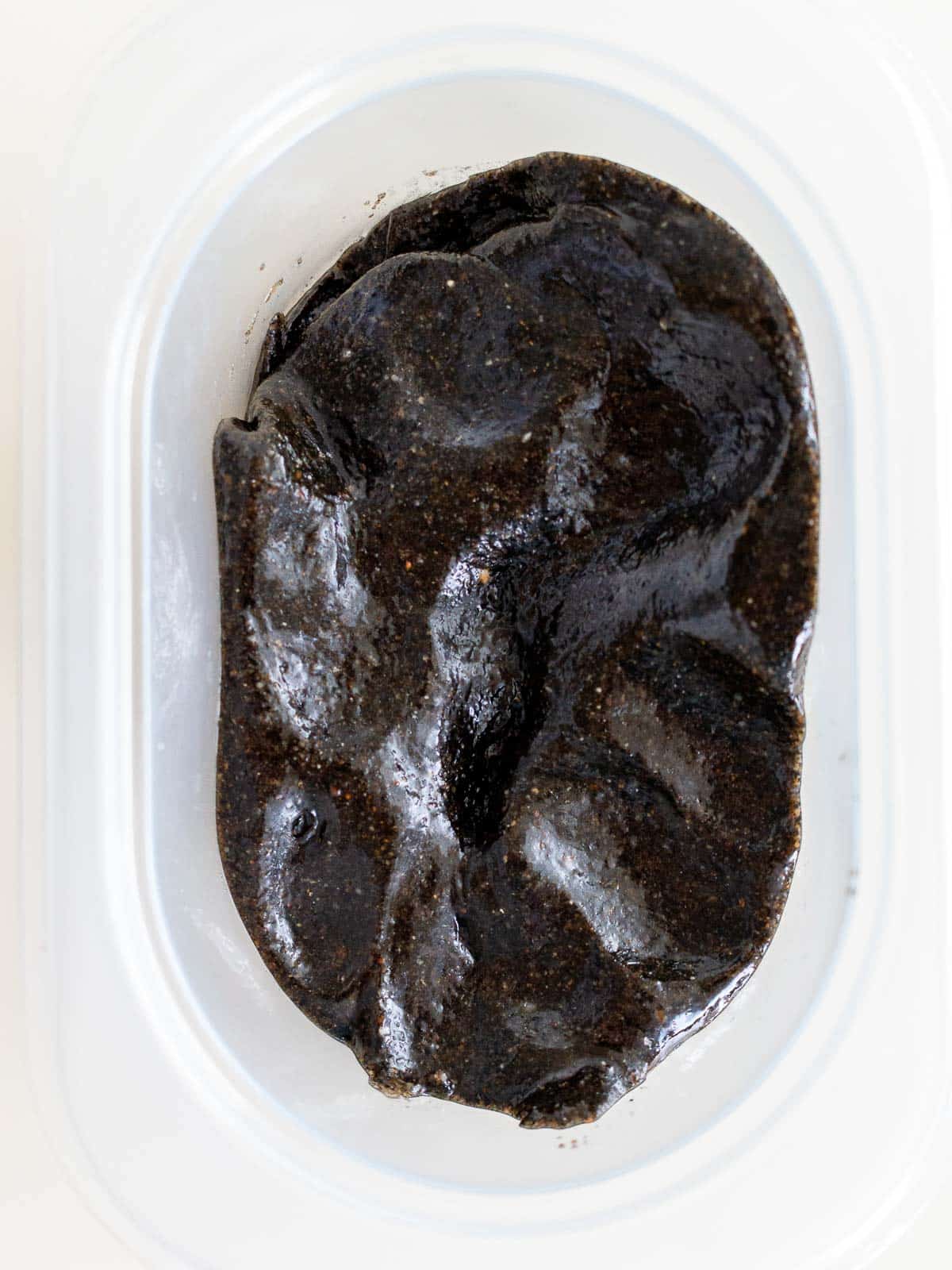
How to Store
Refrigerator: Prepared black sesame paste can be stored in the refrigerator in a covered container for up to a month.
Freezer: For longer storage, you can freeze for up to 6 months in a freezer safe container.
Consistency: When black sesame seed paste is refrigerated, it becomes firmer and thicker. When frozen, it becomes a solid mass. When you are ready to use it, allow the paste to come up to room temperature. This makes the paste more pliable and easier to measure.
Helpful Recipe Tips
- Toast the Seeds: Sauté over low heat for approximately 5 minutes to avoid burning. Alternatively, you can roast sesame seeds in a 350°F (175°C) oven. Place in a single layer on a baking sheet and bake for 8 to 10 minutes. Keep a close eye on them so they do not burn.
- Blend the seeds when slightly warm to allow their natural oils to release.
- Use at least 1 cup of seeds. This quantity ensures proper circulation in the food processor or high-speed blender for smoother blending.
- Hang in There: It takes approximately 5 to 7 minutes to allow the seeds to release their oils. Scrape down the sides of the blender, food processor or mortar periodically.
- Correct Consistency: When the black sesame seeds start releasing their oil the sesame powder starts to stick to the sides. You can continue to blend or add honey or sesame oil to get the paste moving. We chose to keep the paste thick as you can always thin it out later.
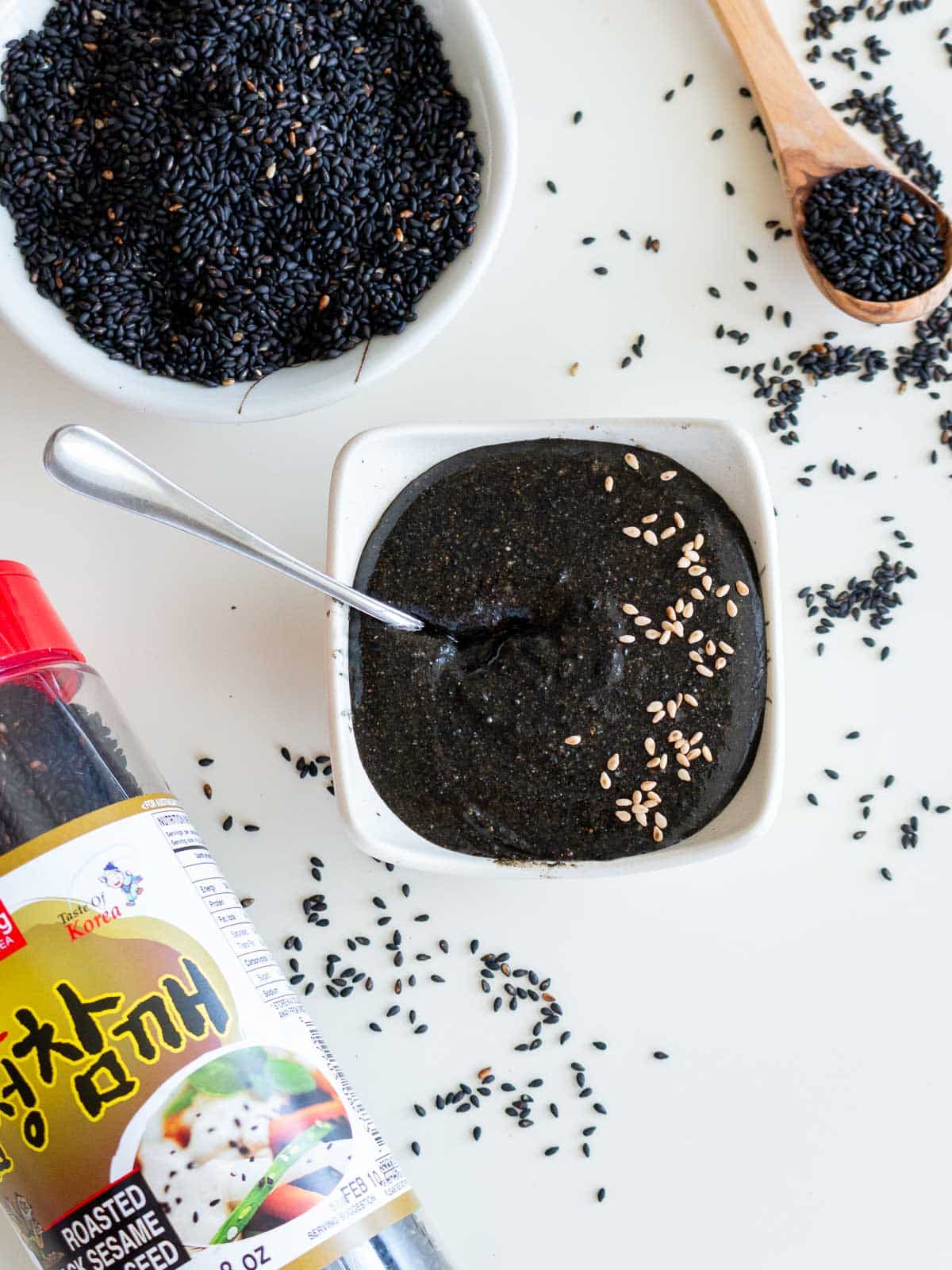
Recipe Hacks Learned the Hard Way!
- Sesame seeds have their own internal oil. Please start out with less honey or sesame oil and just add a little at a time. Start with one tablespoon of honey or 1 teaspoon of sesame oil. Adjust according to your desired sweetness and consistency.
- If you have a powerful food processor or quality high-speed blender - you may not need to add any honey or sesame oil at all.
- Don’t overtax your blender or food processor so it does not overheat the machine. FYI – smoke from the food processor or a funny burning smell coming from the machine is not a good thing.
- If you have a sad little blender like us, you may need more honey or sesame oil to get the homemade black sesame paste going.
- Try using a mortar and pestle to grind the seeds but be prepared to work those arm muscles.
- The more sesame oil or honey you add the thinner the black sesame paste will be. The consistency depends on how you use the recipe. For example, lattes, “nice” creams and sesame pie swirl cookies will do better with a thinner consistency. Whereas, if you need to use it for the filling of a mooncake you will want it thick enough to roll into a ball.
- To measure honey, prime your tablespoon with a little oil or sesame oil before measuring so that it slides right off the spoon.
- When the sesame paste is refrigerated, it will thicken up almost to the texture of a sticky playdough. After you set the sesame seed paste out at room temperature for about 15 minutes, it will return to a more spreadable liquid state.
Frequent Asked Questions (FAQ’s)
No, they are different. Black sesame tahini is usually made by grinding “raw” hulled black sesame seeds into a thin pourable sauce. It is more bitter compared to black sesame paste. Comparatively, black sesame paste is made from “toasted” black sesame seeds and is thicker and naturally sweeter than tahini. You can customize the paste by adding ingredients like honey, sesame oil, or other sweeteners. Add a little at a time to achieve your preferred taste and consistency.
Please note that unopened roasted sesame seed packages have approximately a 2-year shelf life. However, once opened, they should be used within 6 months, or they can go rancid. In addition, raw sesame seeds have a shorter shelf life than roasted sesame seeds.
Black sesame seeds are a neutral food (neither warming or cooling). They may help tonify the liver and kidneys, nourish the blood and help with constipation according to traditional Chinese Medicine. In Critical Reviews in Food Science and Nutrition, Sesame seeds contain a unique lignan called sesamin. Sesamin is a phytoestrogen, which means it has a chemical structure like estrogen but is derived from plants. It is recognized for its potential health benefits, including antioxidant and anti-inflammatory properties.
More Recipes Using Sesame Seeds
Did You Like Our Recipe? Leave a ⭐⭐⭐⭐⭐ rating and/or a review in the comments section below. Your feedback is always appreciated! Follow us for more delicious recipes on Pinterest, Instagram, Twitter and Facebook! Don't forget to sign up for our email list for more free recipes.
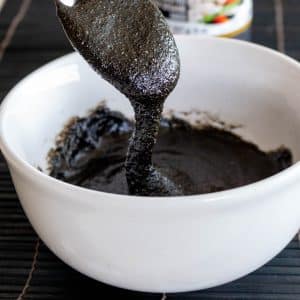
Homemade Black Sesame Paste
Equipment
- food processor or high speed blender or mortar and pestle
Ingredients
Sweetened Black Sesame Paste
- 1 cup black sesame seeds unhulled and organic is best. Either toasted or raw.
- 5 Tablespoons honey or to desired consistency
Unsweetened Black Sesame Paste
- 1 cup black sesame seeds unhulled and organic is best. Either toasted or raw.
- 1-1.5 tablespoons sesame oil or to desired consistency
Instructions
- In a dry pan, sauté toasted black sesame seeds over low heat for approximately 5 minutes until aromatic and warmed. Stir frequently. If sesame seeds are raw, you will need between 8 to 10 minutes over low heat.
- While the sesame seeds are still warm, use a food processor, high-powered blender or a mortar and pestle and grind the seeds until it resembles a fine, sandy texture. Periodically pause the device 3 to 4 times and scrape down the sides to move the seeds down to the blades of the machine or center of the mortar. Continue to pulse and blend the black sesame seeds until they start to extract the oils from within the seeds and longer, if your blender or food processor allows it. (It looks and feels like wet packed sand) This process takes about 3 minutes.
SWEETENED:
- Add honey 1 tablespoon at a time for a total between 4-5 tablespoons or until the desired texture of thick but spreadable is achieved. The paste should be smooth, glossy, sticky and slowly flow from a spoon.
UNSWEETENED:
- The unsweetened version add 1 teaspoon at a time of sesame oil to approximately 1 to 1.5 tablespoons to the ground sesame seeds or until you achieve your desired texture of thick but spreadable is achieved. The paste should be smooth, glossy, sticky and slowly flow from a spoon.
STORAGE:
- Place homemade black sesame seed paste in a clean container with lid and store in the refrigerator for up to a month. For longer storage, you can freeze for up to 6 months in a freezer safe container.
Video
Notes
- calories - 98 kcal
- carbohydrates - 4 grams
- protein - 3 grams
- fat - 9 grams
- saturated fat - 1 gram
- sodium - 2 grams
- potassium - 70 mg
- fiber 2 grams
- sugar - 0.04 grams
- calcium - 146 mg
- iron - 2mg
- To make this recipe vegan exchange the honey 1:1 with maple syrup or agave.
- Sesame seeds have their own internal oil so start out with less honey or sesame oil and just add a little at a time. Start with one tablespoon of honey or 1 teaspoon of sesame oil and adjust according to your desired sweetness and consistency.
- If you have a powerful food processor or quality high-speed blender - you may not need to add any honey or sesame oil at all.
- Don’t overtax your blender or food processor so it does not overheat the machine.
- The more sesame oil or honey you add the thinner the black sesame paste will be.
- Optional: To measure honey, prime your tablespoon with a little oil or sesame oil before measuring so that it slides right off the spoon.
- When the sesame paste is refrigerated, it will thicken up almost to the texture of a sticky playdough. However, once you set it out for about 15 minutes at room temperature and gently stir, it will return to a more liquid state.


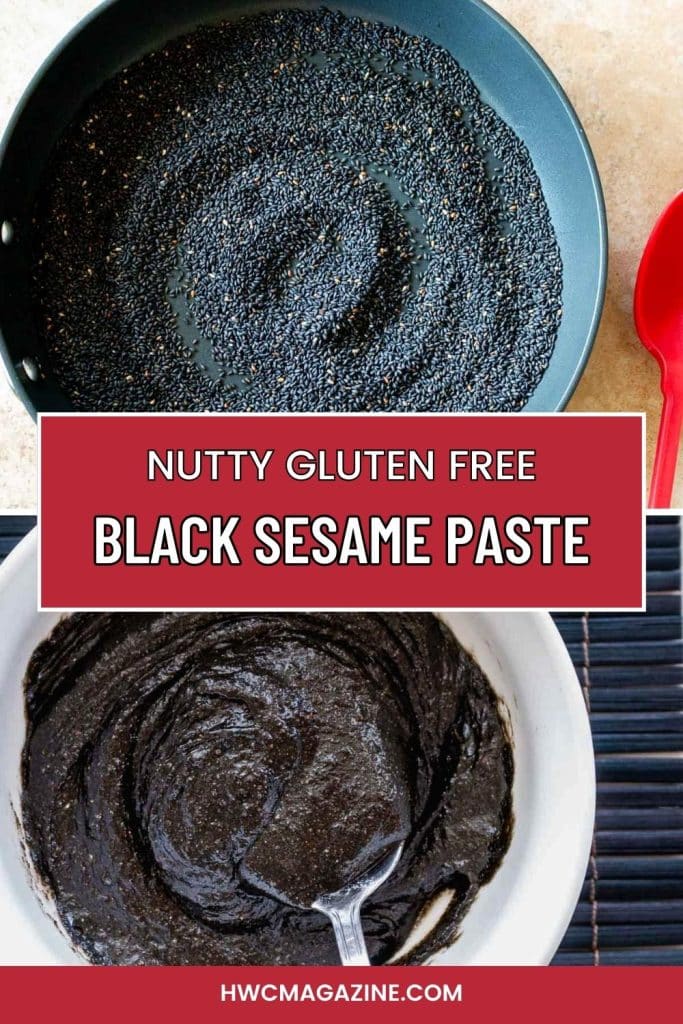
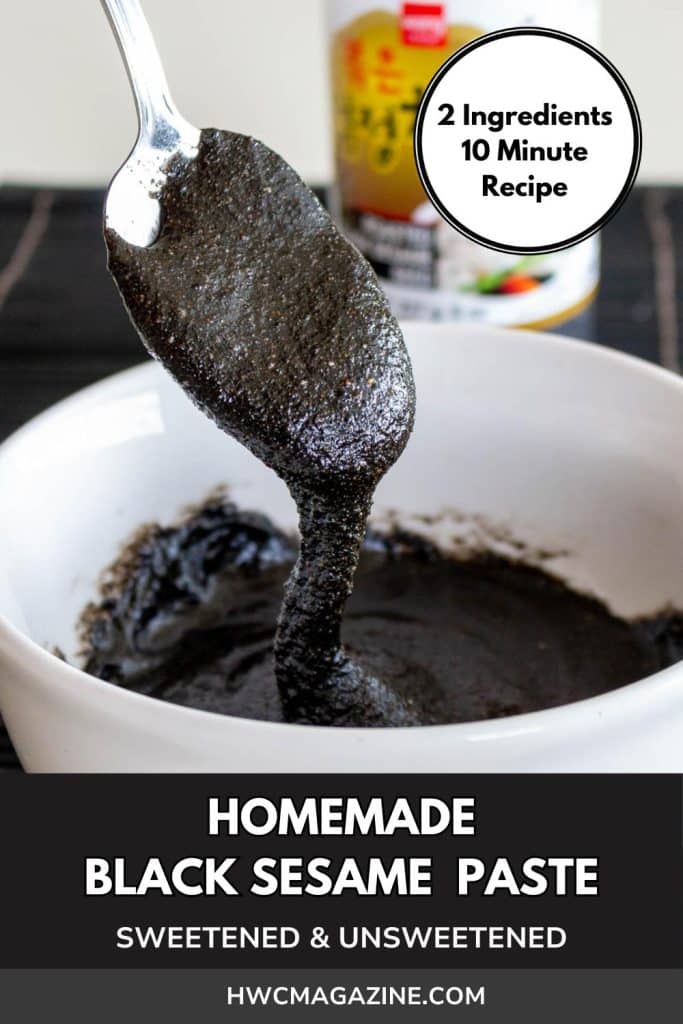
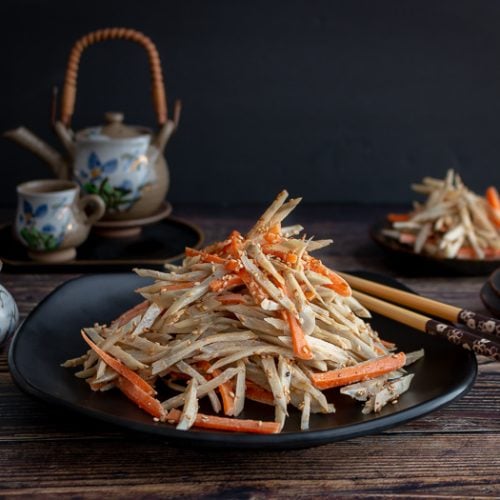
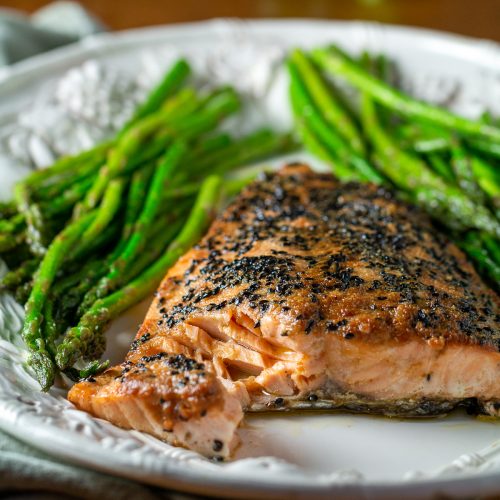
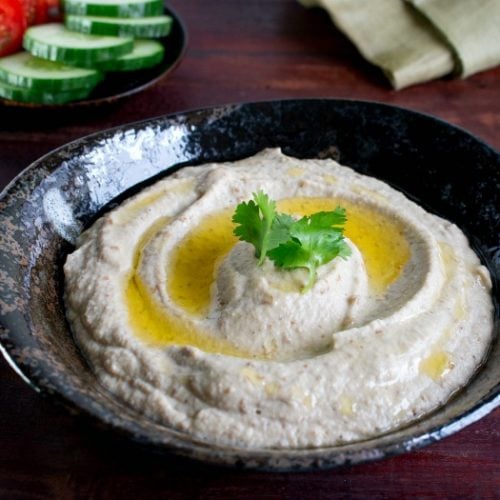
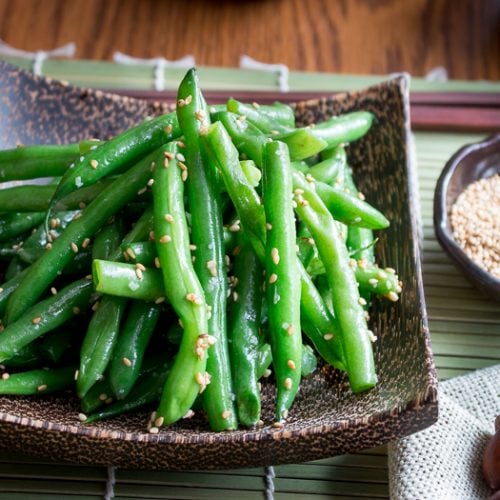
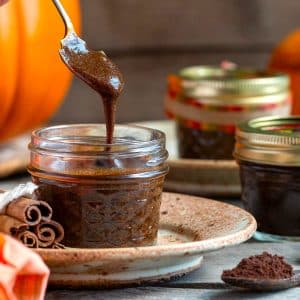

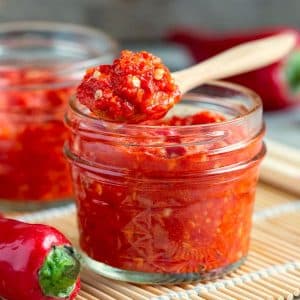


Natalia says
I love black sesame flour! I've made pancakes, GF/vegan bread, added it to my Smoothie bowls, mashed sweet potatoes, etc.. It's so versatile and nutritious. I've made the sweetened version of this paste but never the unsweetened. would the unsweetened be used similar to a traditional tahini?
HWC Magazine says
Hi there Natalia! We love black sesame too. Unsweetened black sesame paste is made using "roasted" black sesame seeds. We think it has a deeper and richer flavor compared to unroasted tahini paste. You can use unsweetened homemade black sesame paste in savory recipes like noodles, sauces, in salad dressings, roasted veggies, etc. much like you would traditional tahini. Wishing you a super weekend ahead.
Valentina says
I am loving this and will use it next time I need the paste. I'd only used store bought in the past (gasp!). I just added a link to this in my choc chip black sesame ice cream psot. 🙂 ~Valentina
HWC Magazine says
So glad you found our homemade black sesame paste recipe helpful and thank you!
Heidi | The Frugal Girls says
I loved all of your suggestions for how to use this yummy 2 ingredient black sesame paste. Drizzling some of it over my oatmeal sounds so dreamy good!
HWC Magazine says
Thank you Heidi! Love black sesame paste over oatmeal too. It's warming and nutty and simply addicting.
Hannah says
There's nothing like a good black sesame paste, and I definitely can't find that in stores around here. Thankfully, it's so affordable and simple to make your own! I definitely needed this reminder, I've gotta get on this ASAP.
HWC Magazine says
Thank you Hannah. Homemade is so much better than store bought! Deeply roasted black sesame seeds is the key to a delicious paste.
Valentina says
I'll definitely try this. I've always bought it because I don't use it very often, but I think it would be much better homemade. I use it to make black sesame ice cream, and now I must make your cookies with it. 🙂 ~Valentina
HWC Magazine says
Homemade black sesame paste is so much better and nuttier compared to store bought and you know exactly what is in it too. We have been on a roll with lots of desserts so stay tuned as many more delicious black sesame recipes are coming your way.